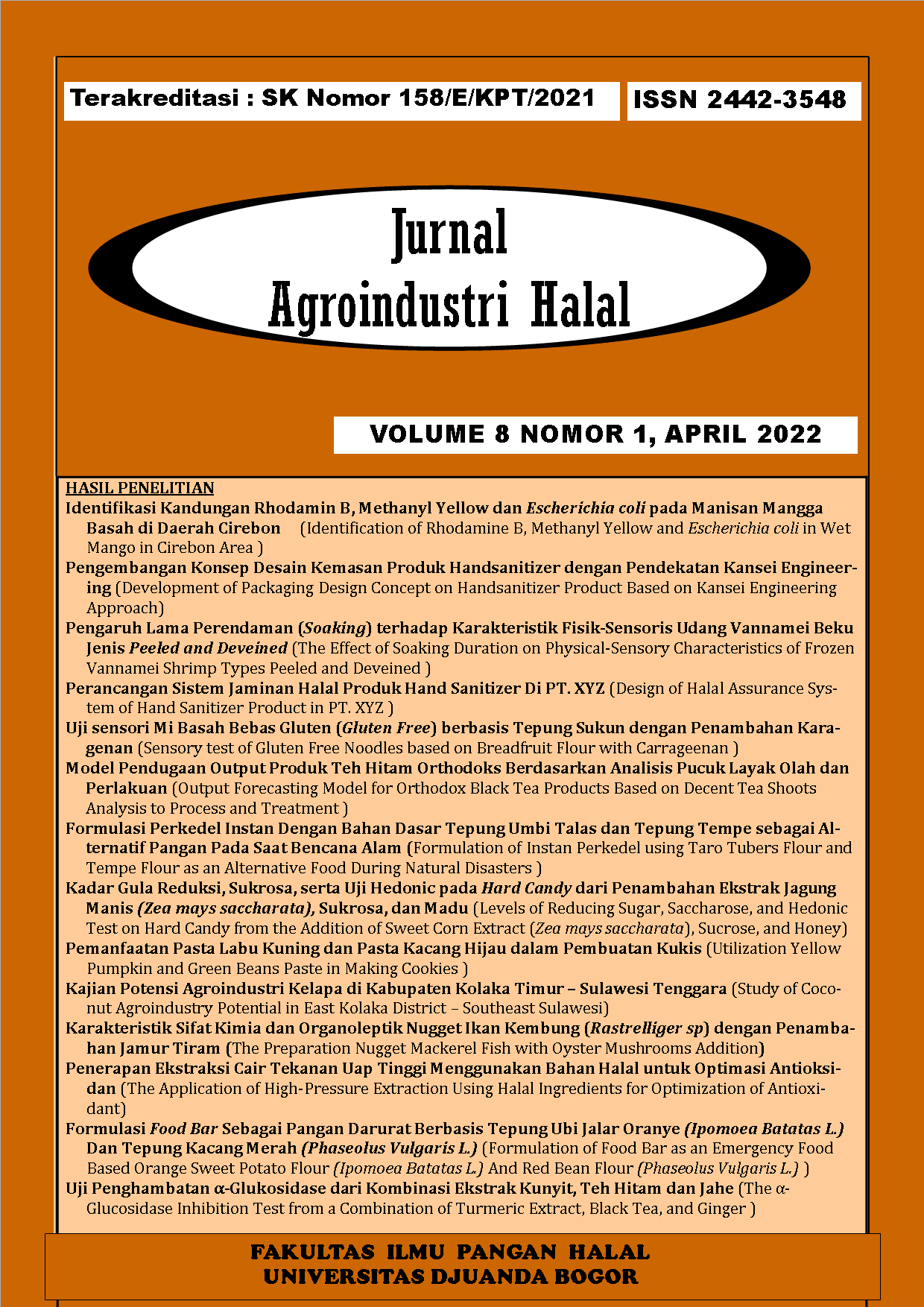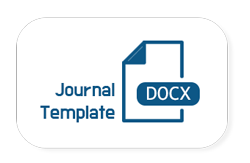Uji Penghambatan α-Glukosidase dari Kombinasi Ekstrak Kunyit, Teh Hitam dan Jahe
The α-Glucosidase Inhibition Test from a Combination of Turmeric Extract, Black Tea, and Ginger
DOI:
https://doi.org/10.30997/jah.v8i1.5608Keywords:
diabetes mellitus, black tea, turmeric, ginger, α-glucosidase inhibitionAbstract
Traditional medicines that can be used as α-glucosidase inhibitors are turmeric (Curcuma longa L.), black tea (Camellia sinensi L), and ginger (Zingiber officinale). It is necessary to research the use of a combination of tea, turmeric, and ginger in inhibiting the α -glucosidase enzyme. This study aims to determine the optimal combination of extracts of turmeric, black tea, and ginger in inhibiting the α-glucosidase enzyme. The research carried out was the measurement of IC50 values for the inhibition of α-glucosidase of each extract, and the inhibition of the enzyme α-glucosidase in combination. The results of the test of ethanol extract of turmeric, ginger and black tea water extract obtained the inhibition value of α-glucosidase with IC50 values of 9.48±0.05 g/mL, 66.64±0.44 g/mL and 9.52±0.25, respectively. F7 is a combination of turmeric, ginger and black tea which produces the highest α-glucosidase inhibition, which is 67.86±0.93%.
References
International Diabetes Federation. (2019). IDF diabetes atlas (9th ed.). International Diabetes Federation.
Adeniyi, P.O., & Sanusi, R.A. (2014). Effect of ginger (Zingiber officinale) extracts on blood glucose in normal and streptozotocin-induced diabetic rats. Int J of Clinical Nutrition, 2(2), 32-35.
Adeyeoluwa, T. E, Balogun, F. O., & Ashafa, A. O. T. (2020). In vitro comparative assessment of the inhibitory effects of single and combined spices against glucose-synthesizing enzymes. Tropical Journal of Pharmaceutical Research, 19(6), 1209-1214.
Andersen, J., & Markham, A. (eds.). 2006. Flavonoids. CRC.
Anjarsari, I. R. D. (2016). Katekin teh Indonesia: prospek dan manfaatnya. J Kultiv, 15(2), 99-106.
Azzeh, F. S. (2013). Synergistic effect of green tea, cinnamon and ginger combination on enhancing postprandial blood glucose. Pakistan Journal of Biological Sciences, 16(2), 74-79.
Chin, F. S., Chong, K. P., Markus, A., & Wong, N. K. (2013). Tea polyphenols and alkaloids content using soxhlet and direct extraction methods. World Journal of Agricultural Sciences, 9(3), 266-270.
Cihan, A. C., Cokmus. C., & Ozcan. B. (2009). Characterization of thermostable α-glucosidases from newly isolated Geobacillus sp. A333 and thermophilic bacterium A343. World J Microbiol Biotechnol, 25(1), 2205-2217.
Daily, J. W., Yang, M., Kim, D. S., & Park, S. (2015). Efficacy of ginger for treating type 2 diabetes: a systematic review and meta-analysis of randomized clinical trials. Journal of Ethnic Foods, 2(1), 36- 43.
DiNicolantanio, J. J., Bhutani, J., & O’Keefe, J. H. (2015). Acarbose: safe and effective for lowering postprandial hyperglycemia and improving cardiovascular outcomes. Open Heart. 2(1):1-13.
Gupta, R. K., Chawla, P., Tripathi, M., Shukla, A. K, & Pandey, A. (2014). Synergistic antiokxidant activity of tea with ginger, black pepper dan tulsi. International Journal of Pharmacy and Pharmaceutical Science, 6(5), 477-479.
Hakim, Buraerah, H., Abdullah, Zulkifli, A., & Hanis, M. (2009). Analisis faktor resiko diabetes melitus tipe 2 di Puskesmas Tanrutedong, Sidenreng Rappang, 2007. MEDIKA: Jurnal Kedokteran Indonesia, 35(4), 228-237.
Hasimun, P., Adnyana, I. K., Valentina, R., & Lisnasari, E. (2016). Potential alpha-glucosidase inhibitor from selected zingiberaceae family. Asian Journal of Pharmaceutical and Clinical Research, 9(1), 164-167.
Herbian, D., Choi, J. H., El-Aty, A. M. A., Shim, J. H., & Spiteller, M. (2009). Metabolite analysis in Curcuma domestica using various GC-MS and LC-MS separation and detection techniques. Biomed. Chromatogr, 23(9), 951–965
Holidah, D., Yasmin, Christianty, F. M. (2018). Uji antidiabetes ekstrak teh hitam dan teh hijau secara in vitro menggunakan meode inhibisi enzim α-glukosidase. E-Jurnal Pustaka Kesehatan, 6(2), 235-239.
Kamiyama, Sanae, Ikeda, Higashi, Minami, Asano. (2010). In vitro inhibition of α-glucosidases and glycogen phosphorylas by catechin gallates in green tea. Food Chem, 122(4), 1061-1066.
Kartika, A. (2014). Kandungan kurkuminoid, inhibisi α-glukosidase dan sitotoksisitas ekstrak dari beberapa aksesi kunyit (Curcuma domestica Val.). [Skripsi, Institut Pertanian Bogor]. IPB University Scientific Repository.
Khatri, D. K., & Juvekar, A. R. (2014). Α-glucosidase and α-amylase inhibitory activity of Indigofera cordi¬folia seeds and leaves extract. Int J Pharm Pharm Sci, 6(11), 152-5.
Lestari, N. S. (2019). Pengaruh proposi daun jambu biji dan kunyit dalam campuran minuman herbal terhadap penghambatan aktivitas enzim α-amilase dan α-glukosidase. [Skripsi, Universitas Lampung]. LPPM UNILA-IR.
Liu, A., Yu, Z., Zhu, H., Zhang, W., & Chen, Y. (2016). In vitro α-glucosidase inhibitory activity of isolated fractions from water extract of Qingzhuan dark tea. BMC Complementary and Alternative Medicine, 16(378), 1-8.
Nakhaee, A., & Sanjari, M. (2013). Evaluation of effect of acarbose consumption on weight losing in non-diabetic overweight or obese patients in Kerman. J Res Med Sci. 18(5):391-4.
Nurdin, S. U., Sukohar, A., Ramadhani, O. S. (2017). Antiglucosidase and antioxsidant activities of ginger, cinnamon, turmeric and their combination. Internasional Journal of Pharmacy and Pharmaceutical Research, 10(1), 296-306.
Nurfachri, N. (2020). Aktivitas antioksidan dan antidiabetes ekstrak daun gandarusa (Justicia gendarussa Burm. F.) in vitro. [Skripsi, Institut Pertanian Bogor]. IPB University Scientific Repository.
Price, A. S., & Wilson, M. L. (2012). Patofisiologi Vol 2. EGC.
Pujirahayu, A. D. (2019). Aktivitas antioksidan dan bioaktivitas kombinasi fraksi polifenol daun Syzygium polyanthum dengan Guazuma ulmifolia. [Skripsi, Institut Pertanian Bogor]. IPB University Scientific Repository.
Rahim, N. F. A., Muhammad, N., Abdullah, N., Talip, B. A., & Poh, K. H. (2020). The interaction effect and optimal formulation of selected polyherbal extracts towards antioxidant activity. Food Research, 4(6), 2042-2048.
Rahmadhani, O. S. (2016). Uji penghambatan aktivitas enzim alfaglukosidase dan aktivitas antioksidan jahe, kayu manis, kunyit beserta kombinasinya. [Skripsi, Universitas Lampung]. LPPM UNILA-IR.
Riaminanti, N. K., Hartiati, A., & Mulyani, S. (2016). Studi kapasitas dan sinergisme antioksidan pada ekstrak kunyit (Curcuma domestica Val.) dan daun asam (Tamarindus indica L.). Jurnal Rekayasa dan Manajemen Agroindustri, 4(3), 93-104.
Riaz, H., Begum, A., Raza, S. A., Khan, Z. M. U. D., Yousaf, H., & Tariq, A. (2015). Antimicrobial property and phytochemical study of ginger found in local area of Punjab, Pakistan. International Current Pharmaceutical Journal, 4(7), 405-409.
Rohdiana, D. (2015). Teh: proses, karakteristik dan komponen fungsionalnya. Food Review Indonesia, 10(1), 34-37.
Sabir, S. M., Zeb, A., Mahmood, M., Abbas, S. R., Ahmad, Z., & Iqbal, N. (2021). Phytochemical analysis and biological activities of ethanolic extract of Curcuma longa rhizome. Braz. J. Biol, 81(3), 737-740.
Safithri, M. (2012). Kajian mekanisme antihiperglikemik campuran ekstrak daun sirih merah dan kulit kayu manis yang berpotensi sebagai minuman fungsional. [Disertasi, Institut Pertanian Bogor]. IPB University Scientific Repository.
Sancheti, S., Sandesh, S., & Sung, Y. S. (2009). Chaenomeles sinensis: A potent α-and β-glucosidase inhibitor. Am J Pharm and Toxicol, 4(1), 8-11.
Satoh, T., Igarashi, M., Yamada, S., & Takahashi, N., & Watanabe, K. (2015). Inhibitory effect of black tea and its combination with acarbose on small intestinal α-glucosidase activity. Journal of Ethnopharmacology, 161(2015), 147-155.
Shome, S., Talukdar, A. D., & Choudhury, M. D., Bhattacharya, M. K., & Upadhyaya, H. (2016). Curcumin as potential therapeutic natural product: ananobiotechnological perspective. Journal of Pharmacy and Pharmacology, 68(2016), 1481–1500.
Simorangkir, H. A. H. (2020). Mikroenkapsulasi kombinasi curcumin pada kunyit (Curcuma Longa) dan epigallocatechin-3-gallate (EGCG) pada teh hijau (Camellia Sinensis): inovasi terapi pencegahan ellitus retinopati pada penderita diabetes mellitus tipe 2. Scientific Medical Journal, 1(2), 1-11.
Susanto, H., Indra, M. R., & Karyono, S. (2014). Pengaruh sari seduh teh hitam (Camellia sinensis) terhadap ekspresi IGF-1, ERK1/2 dan PPAR pada jalur MAPK (Mitogen Activated Protein Kinase) jaringan lemak viseral tikus wistar dengan diet tinggi lemak. J.Exp. Life Sci, 2(2), 89-97.
Syahrir, N. H. A., Afensi, F. M., & Susetyo, B. (2016). Efek sinergis bahan aktif tanaman obat berdasarkan jejaring dengan protein target. Jurnal Jamu Indonesia, 1(1), 35-46.
Tabatabaei-Malazy, O., Larijani, B., & Abdollahi, M. (2013). A novel management of diabetes by means of strong antioxidants’ combination. Journal of Medical Hypotheses and Ideas, 7(1), 25–30.
Tadera, Minami, Takamatsu, & Matsuoka. (2006). Inhibition of alpha-glucosidase and alphaamylase by flavonoids. J Nutr Sci Vitaminol, 52(2), 149-153.
Widiastuti, L. (2020). Acupressure dan senam kaki terhadap tingkat peripheral arterial disease pada klien DM tipe 2. Jurnal Keperawatan Silampari, 3(2), 649-706.
Yang, X., & Koh, F. (2016). Evaluation of the in vitro aglucosidase inhibitory activity of green tea polyphenols and different tea types. J Sci Food Agr, 96(3), 777-782.
Yanto, A. R., Mahmudati, N., & Susetyorini, R. E. (2016). Seduhan jahe (Zingiber officinale Rosce.) dalam menurunkan kadar glukosa darah tikus model diabetes melitus tipe-2 (NIDDM) sebagai sumber belajar biologi. Jurnal Pendidikan Biologi Indonesia, 2(3), 258-264.
Yuningtyas, S., & Artianti, D. S. (2015). Aktivitas inhibisi enzim α-glukosidase ekstrak air dan etanol umbi lapis bawang merah (Allisum ascalonicum). Fitofarmaka, 5(1), 24-30.
Downloads
Published
How to Cite
Issue
Section
License

This work is licensed under a Creative Commons Attribution-ShareAlike 4.0 International License.
Authors who publish with Jurnal Agroindustri Halal agree to the following terms:
- Authors retain copyright and grant the journal right of first publication with the work simultaneously licensed under a Creative Commons Attribution 4.0 International License that allows others to share the work with an acknowledgement of the work's authorship and initial publication in Jurnal Agroindustri Halal.
- Authors are able to enter into separate, additional contractual arrangements for the non-exclusive distribution of the journal's published version of the work (e.g., post it to an institutional repository or publish it in a book), with an acknowledgement of its initial publication in Jurnal Agroindustri Halal.
- Authors are permitted and encouraged to post their work online (e.g., in institutional repositories or on their website) prior to and during the submission process, as it can lead to productive exchanges, as well as earlier and greater citation of published work








